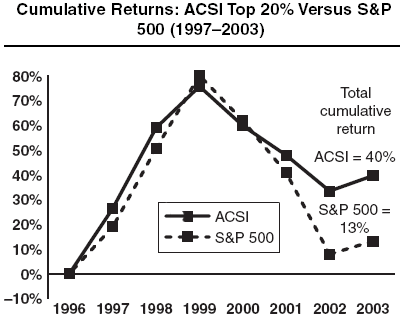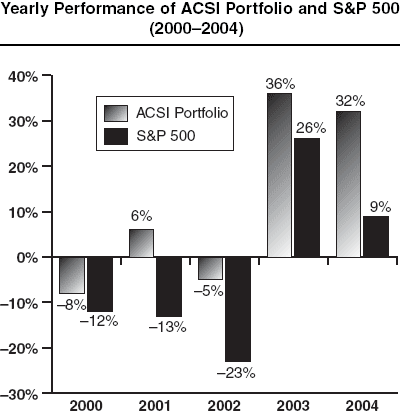Do companies with high marks for customer satisfaction outperform as investments? Or, instead, does making customers happy crimp profit margins and stock returns? In their January 2006 Journal of Marketing article entitled “Customer Satisfaction and Stock Prices: High Returns, Low Risk”, Claes Fornell, Sunil Mithas, Forrest Morgeson III and M.S. Krishnan investigate the relationship between customer satisfaction as measured by the American Customer Satisfaction Index (ACSI) and stock returns. ACSI measurements are updated annually for each company rated. Using ACSI ratings for publicly traded companies during 1994-2004 and associated firm accounting and stock price data, they find that:
- ACSI ratings relate significantly to market valuation. A 1% change in ACSI is associated with a 4.6% change in market value.
- News about ACSI ratings (161 isolated news events for 89 companies) does not reliably move stock prices over the short term.
- During 2/18/97-5/21/03, a portfolio of stocks in the top 20% of ACSI ratings (relative to their competition) and
above the ACSI national average generates a cumulative return of 40% (excluding dividends and transaction costs), compared to 13% for the S&P 500 index. (See the first chart below.) The beta for this portfolio is a low 0.78. Neither the value premium nor the size effect explains the outperformance. - A portfolio that is long (short) stocks with high and increasing (low and decreasing) ACSI ratings outperforms the S&P 500 index every year during 4/11/00-12/31/04, often by a considerable margin. The ACSI long-short portfolio produces a cumulative gain over this period of 75%, compared to a loss of 19% for the S&P 500 index. The mean beta for the long-short portfolio is a low 0.77 relative to the S&P 500 index. Short positions generate only 3% of the total return, suggesting asymmetric impacts from high versus low customer satisfaction.
The following chart, taken from the paper, compares cumulative return over 2/18/97-5/21/03 for a portfolio of firms in the top 20% of ACSI (relative to their competition) and above the ACSI national average (about 20-30 companies per year) to that for the S&P 500 index. The portfolio buys (sells) shares at the closing price on the day new annual ACSI ratings qualify (disqualify) them for the portfolio. Results do not include dividends or transaction costs.

The next chart, also from the paper, compares annual performance of a portfolio that is long (short) stocks with high and increasing (low and decreasing) ACSI ratings with that of the S&P 500 index over the period 4/11/00-12/31/04. The short positions are generally small, ranging from 0% to 20% of portfolio value. Periodic rebalancing equalizes position sizes without regard to release dates for new ACSI ratings. Results include reinvested dividends and transaction costs. The chart shows that the ACSI long-short portfolio consistently outperforms the S&P 500 index.

In summary, stocks of firms with high ACSI customer satisfaction ratings outperform the market on average over the long term. Said differently, investors appear to undervalue customer satisfaction systematically.